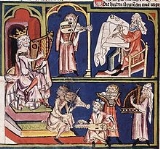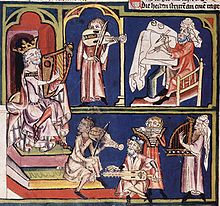
Rudolf von Ems
Encyclopedia
Rudolf von Ems was a mediaeval Austrian
epic
poet.

in Austria
. He took his name from the castle of Hohenems
near Bregenz
, and was a knight in the service of the Counts of Montfort. His works were written between 1220 and 1254. He is thought to have died whilst accompanying King Conrad IV
on his advance into Italy.
He was one of the most learned and also most productive poets of his time, although not all his works are preserved. Those that are, were distinguished by grace and sincerity in the narration, strict morality and technical mastery. He himself describes Gottfried von Strassburg
as his ideal; this is quite credible, as he sometimes quotes literally from "Tristan
". He also adopted Gottfried's technique of making literary excursuses in which he names works of contemporaries and of his own.
He is thought to have died in Italy in 1254.
 Of his surviving works, the tale Der gute Gerhard (Gerhard the Good) is the oldest and also the best, a depiction of Christian
Of his surviving works, the tale Der gute Gerhard (Gerhard the Good) is the oldest and also the best, a depiction of Christian
humility, probably based on a Latin
source.
This was followed by Barlaam and Josaphat, dating from approximately 1225 to 1230, taken from a Latin translation of a Greek version of the story of the conversion of an India
n prince to Christianity
(a story which is believed in fact to be that of the Buddha
, at many removes); and by Wilhelm von Orlens, the story of the childhood love of Willehalm and Amelie, who are among the most famous lovers of the Middle Ages
.
His Alexanderroman (Romance of Alexander), written about 1240, is a fragment. In 21,000 verses the upbringing and battles of Alexander are depicted, in which the hero is a model of knightly virtue. Rudolf's sources for this work were principally the Historia de preliis and the Historiae Alexandri Magni of Curtius Rufus
.
The Chronicle of the World (Weltchronik) is Rudolf's last work, dedicated to King Conrad IV. It narrates, as an addition to the Bible
, the Historia scholastica
of Petrus Comestor
and the Pantheon of Godfrey of Viterbo
, the history of the world from the creation up to the death of King Solomon, with the added motive of legitimizing the rule of the Hohenstaufen dynasty
. As early as the 13th century this work was combined in many manuscripts with the Christherre-Chronik
.
A further work, Eustachius, is lost.
This article is largely translated from that in the German Wikipedia
Austrians
Austrians are a nation and ethnic group, consisting of the population of the Republic of Austria and its historical predecessor states who share a common Austrian culture and Austrian descent....
epic
Epic poetry
An epic is a lengthy narrative poem, ordinarily concerning a serious subject containing details of heroic deeds and events significant to a culture or nation. Oral poetry may qualify as an epic, and Albert Lord and Milman Parry have argued that classical epics were fundamentally an oral poetic form...
poet.

Life
Rudolf von Ems was born in the VorarlbergVorarlberg
Vorarlberg is the westernmost federal-state of Austria. Although it is the second smallest in terms of area and population , it borders three countries: Germany , Switzerland and Liechtenstein...
in Austria
Austria
Austria , officially the Republic of Austria , is a landlocked country of roughly 8.4 million people in Central Europe. It is bordered by the Czech Republic and Germany to the north, Slovakia and Hungary to the east, Slovenia and Italy to the south, and Switzerland and Liechtenstein to the...
. He took his name from the castle of Hohenems
Hohenems
Hohenems is a town in the westernmost Austrian state of Vorarlberg, in the Dornbirn district. It lies in the middle of the Austrian part of the Rhine valley. With a population of 15,200 it is the fifth largest municipality in Vorarlberg...
near Bregenz
Bregenz
-Culture:The annual summer music festival Bregenzer Festspiele is a world-famous festival which takes place on and around a stage on Lake Constance, where a different opera is performed every second year.-Sport:* A1 Bregenz HB is a handball team....
, and was a knight in the service of the Counts of Montfort. His works were written between 1220 and 1254. He is thought to have died whilst accompanying King Conrad IV
Conrad IV of Germany
Conrad IV was king of Jerusalem , of Germany , and of Sicily .-Biography:...
on his advance into Italy.
He was one of the most learned and also most productive poets of his time, although not all his works are preserved. Those that are, were distinguished by grace and sincerity in the narration, strict morality and technical mastery. He himself describes Gottfried von Strassburg
Gottfried von Strassburg
Gottfried von Strassburg is the author of the Middle High German courtly romance Tristan and Isolt, an adaptation of the 12th-century Tristan and Iseult legend. Gottfried's work is regarded, alongside Wolfram von Eschenbach's Parzival and the Nibelungenlied, as one of the great narrative...
as his ideal; this is quite credible, as he sometimes quotes literally from "Tristan
Gottfried von Strassburg
Gottfried von Strassburg is the author of the Middle High German courtly romance Tristan and Isolt, an adaptation of the 12th-century Tristan and Iseult legend. Gottfried's work is regarded, alongside Wolfram von Eschenbach's Parzival and the Nibelungenlied, as one of the great narrative...
". He also adopted Gottfried's technique of making literary excursuses in which he names works of contemporaries and of his own.
He is thought to have died in Italy in 1254.
Works

Christian
A Christian is a person who adheres to Christianity, an Abrahamic, monotheistic religion based on the life and teachings of Jesus of Nazareth as recorded in the Canonical gospels and the letters of the New Testament...
humility, probably based on a Latin
Latin
Latin is an Italic language originally spoken in Latium and Ancient Rome. It, along with most European languages, is a descendant of the ancient Proto-Indo-European language. Although it is considered a dead language, a number of scholars and members of the Christian clergy speak it fluently, and...
source.
This was followed by Barlaam and Josaphat, dating from approximately 1225 to 1230, taken from a Latin translation of a Greek version of the story of the conversion of an India
India
India , officially the Republic of India , is a country in South Asia. It is the seventh-largest country by geographical area, the second-most populous country with over 1.2 billion people, and the most populous democracy in the world...
n prince to Christianity
Christianity
Christianity is a monotheistic religion based on the life and teachings of Jesus as presented in canonical gospels and other New Testament writings...
(a story which is believed in fact to be that of the Buddha
Gautama Buddha
Siddhārtha Gautama was a spiritual teacher from the Indian subcontinent, on whose teachings Buddhism was founded. In most Buddhist traditions, he is regarded as the Supreme Buddha Siddhārtha Gautama (Sanskrit: सिद्धार्थ गौतम; Pali: Siddhattha Gotama) was a spiritual teacher from the Indian...
, at many removes); and by Wilhelm von Orlens, the story of the childhood love of Willehalm and Amelie, who are among the most famous lovers of the Middle Ages
Middle Ages
The Middle Ages is a periodization of European history from the 5th century to the 15th century. The Middle Ages follows the fall of the Western Roman Empire in 476 and precedes the Early Modern Era. It is the middle period of a three-period division of Western history: Classic, Medieval and Modern...
.
His Alexanderroman (Romance of Alexander), written about 1240, is a fragment. In 21,000 verses the upbringing and battles of Alexander are depicted, in which the hero is a model of knightly virtue. Rudolf's sources for this work were principally the Historia de preliis and the Historiae Alexandri Magni of Curtius Rufus
Quintus Curtius Rufus
Quintus Curtius Rufus was a Roman historian, writing probably during the reign of the Emperor Claudius or Vespasian. His only surviving work, Historiae Alexandri Magni, is a biography of Alexander the Great in Latin in ten books, of which the first two are lost, and the remaining eight are...
.
The Chronicle of the World (Weltchronik) is Rudolf's last work, dedicated to King Conrad IV. It narrates, as an addition to the Bible
Bible
The Bible refers to any one of the collections of the primary religious texts of Judaism and Christianity. There is no common version of the Bible, as the individual books , their contents and their order vary among denominations...
, the Historia scholastica
Historia scholastica
The Historia Scholastica is a twelfth-century Biblical paraphrase written in Medieval Latin by Petrus Comestor. Sometimes called the "Medieval Popular Bible", it draws on the Bible and other sources, including the works of classical scholars and the Fathers of the Church, to present a universal...
of Petrus Comestor
Petrus Comestor
-Biography:Born in Troyes, he was first attached to the Church of Notre-Dame in that city and habitually signed himself as "Presbyter Trecensis". Before 1148 he became dean of the chapter and received a benefice in 1148. About 1160 he formed one of the Chapter of Notre-Dame at Paris, and about the...
and the Pantheon of Godfrey of Viterbo
Godfrey of Viterbo
Godfrey of Viterbo was a Roman Catholic chronicler, either Italian or German.-Biography:He was probably an Italian by birth, although some authorities assert that he was a Saxon German like his imperial patrons...
, the history of the world from the creation up to the death of King Solomon, with the added motive of legitimizing the rule of the Hohenstaufen dynasty
Hohenstaufen
The House of Hohenstaufen was a dynasty of German kings in the High Middle Ages, lasting from 1138 to 1254. Three of these kings were also crowned Holy Roman Emperor. In 1194 the Hohenstaufens also became Kings of Sicily...
. As early as the 13th century this work was combined in many manuscripts with the Christherre-Chronik
Christherre-Chronik
The Christherre-Chronik is a 13th-century world chronicle from Thüringen, written in Middle High German rhyming couplets. It was written by a churchman in the service of Henry III, Markgrave of Meissen, and may be seen as attempting a spiritual answer to the courtly world chronicle of Rudolf von...
.
A further work, Eustachius, is lost.
Editions of works
- Anon, 1967. Rudolf von Ems: Weltchronik. Aus der Wernigeroder Handschrift herausgegeben von Gustav Ehrismann. 2nd ed., Dublin: Weidmann: Deutsche Texte des Mittelalters 20.
- Asher, John, 1989. Rudolf von Ems, Der guote Gêrhart. 3rd ed., Tübingen: Altdeutsche Textbibliothek 56.
- Junk, Victor, 1928-29 repr. 1970. Rudolf von Ems, Alexander. Ein höfischer Versroman des 13. Jahrhunderts, 2 vols. Darmstadt: Wiss. Buchgesellschaft (unaltered reissue of the Leipzig edition of 1928-29).
- Pfeiffer, 1843 repr. 1965. Barlaam und Josaphat''. Leipzig.
External links
- Brief article at AEIOU (Austrian Online Encyclopaedia)
- Heidelberg MS of "Willehalm von Orlens"
- Meyers Konversationslexikon Online: Rudolf von Ems
This article is largely translated from that in the German Wikipedia

